By Christopher Cozier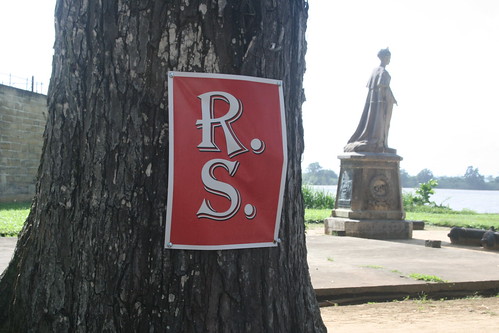
Kurt Nahar’s 8 Dec 1982 installation at Fort Zeelandia; photo by Christopher Cozier
Often when I think of monuments in the Caribbean I think only of the commemoration of historically remote events, and most of the time in a passive and almost indifferent way. We think of a lost moment and of the attempt to preserve or project its value. These questions have been with me since my first visits to Paramaribo, observing the projects of artists Marcel Pinas and Kurt Nahar. There are so many commemorative statues and structures in this city. Somehow they seem to reduce rather than to expand or ignite curiosity. They just fit in, and the snow-cone cart, concert poster, or bus decoration seems to register more definitively or assertively on my mind. As in many other Caribbean locations, there remains a tension between formal and informal markers as you move around Paramaribo.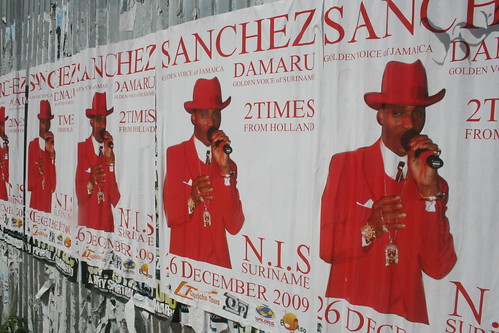
Concert poster, Paramaribo; photo by Christopher Cozier
Kurt Nahar’s project at Fort Zeelandia, 8 Dec 1982, refers to the date of what are called the December Killings. Fifteen people — trade unionists, journalists, academics, and soldiers — known to be opposed to the government, were rounded up, interrogated, tortured, and killed in this fort.
Marcel Pinas’s Moiwana monument commemorates the November 1986 massacre of over thirty men, women, and children during Suriname's civil war, at the actual site of the tragedy on the road between Moengo and Albina. This was the home of the rebel leader Ronnie Brunswijk.
Both artists bring up ideas about how or why we should remember in ways that are circumspect about nationhood’s promises. They bring up issues about the relationship between art and local politics in a fragile democracy. They take this on in an era very different from that of Waka Tjopu, for example, a moment traditionally associated with political engagement and the social value of visual production. A time when terms like “struggle” and “progressive” had a particular charge.
For Pinas and Nahar, these investigative works fuse ideas of personal and collective interests reaching beyond the immediate moment or place. They seek to interrogate the purpose of visual production and the strategies of articulating the challenges of contemporary Caribbean society. As a Ndjuka, Pinas has been articulating presence and visibility throughout his entire career by highlighting the visual language, culture, and social challenges of his community. Nahar, from an urban “creole” backgound, has incorporated this event into his practice. Through the dissonance of associative random fragments on the surface of his collages, he assembles an alternate view of our reality by abandoning the rational to rearrange and re-see. His ongoing interrogative stance and process collides with or arrives at this current political moment.
Optimistically and confidently, both artists test out the boundaries of visual and political propriety by referring to these events. It is counter-politics to the manufacture of fear by insecure aggressive regimes. The December Killings were intended to erase opposition while strategically inserting violated ghosts into the daily imagination of the political class. It generated silence while asserting itself into everyday consciousness. Nahar has worked with and around this once unmentionable moment, re-conjuring it to alter the value of how it resides in our memories.
The vengeful acts of Moiwana were aimed at a particular community then residing outside the coastal political embrace that stood in for what is politically called Suriname. Pinas has built a large-scale monument on the actual site in a forceful declarative manner. It is a site for personal rememberance of lost friends and relatives, for ethnic and national reflection, and also an aesthetic/experiential artistic site-specific-work.
Both artists list names and events in their projects. One gesture is temporal, hoping to trigger memory, undermine silence, and generate debate. The other is a permanent structure, monumental in scale, creating a new mapping of social history — a new site for all of us from the wider region to visit and to experience. The Afaka characters on the Moiwana monument (Kibii wi — “protect us”) refer to community and protection. They ask the rest of us why can’t we just live together. This is not a challenge in Suriname alone.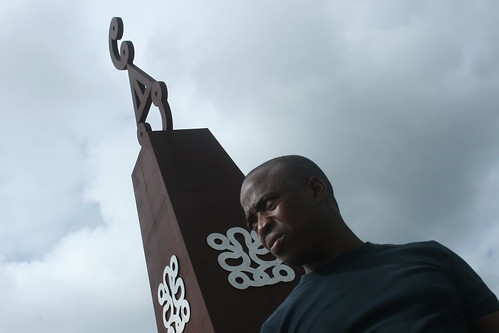
Marcel Pinas at his Moiwana monument; photo by Christopher Cozier
Both of these works talk about very recent and current experiences, events that are still raw and unresolved within living memory. They acknowledge and construct another narrative about the region by rethinking nation/culture and its construction. These gestures have to be seen within the wider narrative of the Caribbean’s social and political history, and also at the boundary of where it meets with that of South America. These works are aimed at political futures. Another election is coming, and the various players of these moments are still alive and among us. The artists want us to remember, but also to imagine a future that can resolve and transform the meaning and the value of these moments.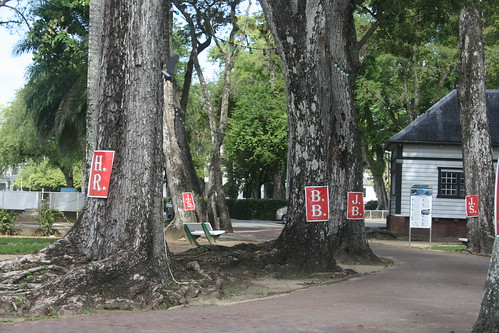

Kurt Nahar’s 8 Dec 1982 installation at Fort Zeelandia; photo by Christopher Cozier
Nahar’s “agitational” mode jettison aesthetic concerns and consciously aims to be caustic — even obnoxious. The way the work is put together expresses an unease, discomfort, and even anger — it seems to be about denying pleasure. One minor concern could be the political implications of the commodification of the December Killings and the expedient usage of the event within electoral politics by interest groups and registered parties. Some have speculated that Nahar’s ongoing concern may also begin to condense the meaning and the possible value of the revolutionary in our historical narrative, and may then obscure what was otherwise accomplished and that may remain unresolved on the road out of colonialism.
Nahar is expressing his concern for the future of his country through highlighting one of its darkest and most challenging moments. He is asking how we can move forward from these unresolved moments. It is a feeling shared throughout the Caribbean, as during the 1980s a number of horrific acts of violence haunted our revolutionary movements and remain with us mostly in popular music, poetry, marginal academic texts, and now more and more through the visual.
Nahar’s strategic lack of composure becomes his way of expressing rage and outrage. The objects are roughly put together, and talk about fragmentation and disharmony and anxiety. Is he asserting that nothing beautiful can come of or from this moment, especially if it remains suppressed and virulent? The work expresses a grasping or gasping — an outburst from a prolonged silence. Unlike the works of previous generations, Nahar is not declaring or invoking an ideal — he is rubbing the lamp, acknowledging a festering reality.
Scattered between the trees around the Fort, which he refers to as “silent witnesses”, bright red posters with the bold initials of the assassinated individuals were nailed to their trunks like sacrificial figures. They looked like standard cheap election posters with their inelegant typography, but instead of smiling, promising faces and catchphrases we got lines of poetry and then just initials. The jarring red tone suggests the violence and the bloodletting of the early 80s as ideological engines, local and internationalist struggles began to simmer. I think of Grenada, Guyana, Trinidad, and Jamaica, as well as other parts of the continent. The internal struggles and the official reactions from Greenbay to Lopinot still haunt us. The heady brew of revolutionary rhetoric and dew breakers, hit squads acting with impunity to maintain the status quo or the Revo from the north to the south of Reagan’s back garden, what was called the Caribbean Basin, are all conjured.
How does a new generation deal with this odd and rapacious Oedipal mask? Does this work then betray the “value” of this revolutionary moment — limit or interrupt its passage into memory and understanding by overstating its darker manifestations, as it allegedly defended its process? Does it highlight the blood-thirsty rationalizations of its imposed optimism and unfulfilled promises?
One can say that the work does not ask about the past as much as it asks about the current moment and the future we are in the process of making — or, as some thinkers suggest, the past imagined futures in which we now reside. That these kinds of political artistic statements can be made now, in Paramaribo, asks an important question about the current state of Surinamese democracy. Will this moment last beyond the outcome of the next election? It also asks about the degree to which artistic expression is seen as agentive or as a large enough social concern. Is it seen as persuasive? It questions the troublesome and vicarious relationship with us, the curators, critics, and exchange artists, with foreign passports and return flights.
Marcel Pinas visiting his Moiwana monument; photo by Christopher Cozier
Pinas’s monument is also operating in this space of questioning. His calm and more composed spatial work looks towards creating an awareness of a newer, more current and pressing question. Ironically, the “creole” nationalist regimes of the region create monuments to rebellion and Emancipation and some even use Maroon culture to symbolise national and cultural resistance within these narratives. Regional monuments speak about the negotiated moment and the gift of freedom towards citizenship for owned entities, ex-slaves but still subjects of the various Crowns within the engine of Modernity.
Cuffy (in Guyana) rages as a primal mystical force, Makandal (in Haiti) blows his shell, Bussa (in Barbados) shakes his fist at the sky (with nice shorts). Two naked and pre-Black statues look at each other not yet aroused in Kingston, like the first steps after the customary drum roll of a Carifesta choreography. And so it goes. Pinas’s work declares a space for thinking, for reflection, rather than objectifying or caricaturing. Is there a way that these officially installed objects obscure or silence unresolved questions about the transformation we hurriedly celebrate in the Post-Independence space?
But the Moiwana monument asks a question or declares an intention about shared space and community. This is not a narrative of subjected fusion, but one about each cultural self remaining intact while connecting and communicating. The work also ventures into inscribing new regional monuments or moments for reflection — new sites of memory and commemoration.
So this gesture is both a personal and a community concern, national and transnational. It recognises those made absent not just in the massacre but in the social dynamics of the country itself. It speaks not just to Suriname but through its scale to all humanity when we falter. Recent events in Albina indicate the fragility of these relations, and the resentments shaped by a long history of neglect.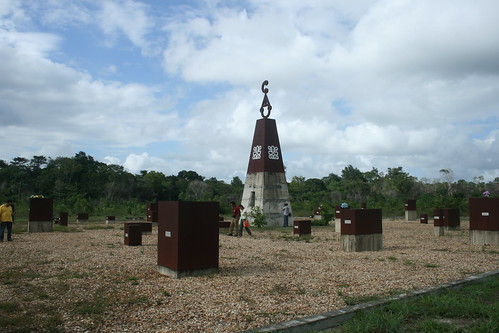
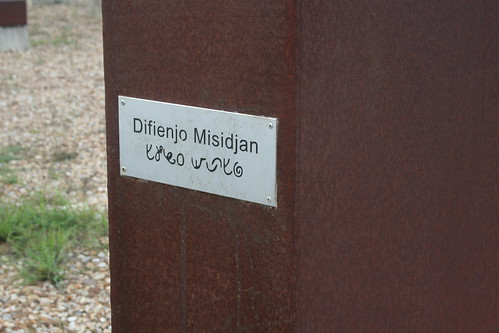
Marcel Pinas’s Moiwana monument; photos by Christopher Cozier
Pinas’s rising object with Afaka signs surrounded by smaller metal and concrete tablets inscribed with the names of those killed sits in a forest clearing. It is always seen against the sky or the heavens, accordingly. The sound of the wind and the sound and feel of the sharp chipped stone fragments under one’s feet create a harsh effect as you walk around the clearing looking at the names. The sound of the gravel makes one keenly aware of one’s individual presence at this site, and also one’s vulnerability. The meeting point of metal, concrete, and stone rising out of the forest clearing creates a sombre tone, as one tries to conjure the moment in a small rural village setting. Again the trees in the forest are like silent witnesses surrounding the site.
The state has recognised these injustices and investigations, and court cases continue while the artists process these memories and feelings. The artists are not seeking justice or retribution, but to excavate these memories for illumination and reconciliation. Ultimately, Pinas and Nahar seek to alter the emotional and political value of these moments.
Postscript:
While writing this note, I saw a series of images by photographer Harvey Lisse, posted on Facebook. Titled “Black Beauties”, the photos simply use Fort Zeelandia as a backdrop or texture to capture the beauty and lightheartedness of a young Surinamese woman. It’s a glamour series, the stereotypical kind of images that young guys with cameras take of beautiful young women. The urban cool of the era of Vibe magazine is conjured. Even though conventional in terms of how women may traditionally reside within the frame, some of the images take in a non-conventional implication when one thinks of the chosen location. In an image called “against the wall”, a young woman leans against the wall of the fort looking back at the viewer. One has to stop and wonder: is the artist winking or just oblivious? Either is critically interesting, as a vantage point or step along the way from previous readings of the site. In these images, the black body or self is not a violated presence but a celebrated one. In this way, Lisse’s images may be heading to yet another reading of the site, taking us one step further as two historical moments, a colonial fort and a postcolonial dungeon, become merely the backdrop for another creative moment.
Notes: on monuments and moments
Friday, February 19, 2010
Subscribe to:
Post Comments (Atom)




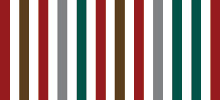

0 comments:
Post a Comment